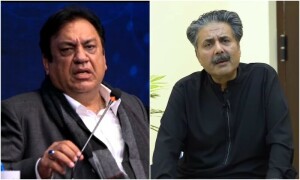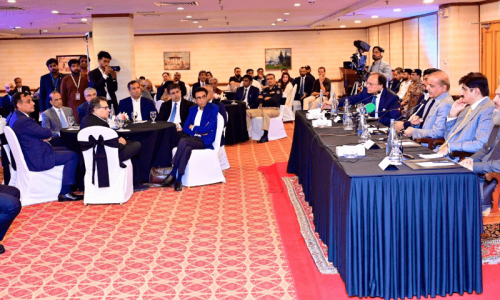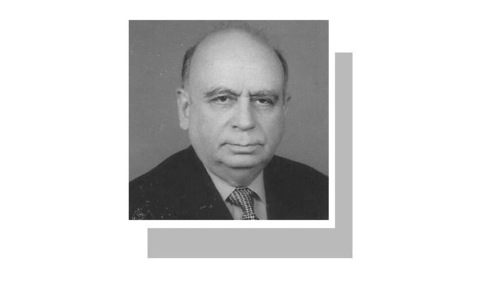
THE PML-N — this version of it — is done. To win re-election from here would be a spectacular, historic, mind-boggling victory.
A victory so spectacular, historic and mind-boggling that it would turn on its head everything anyone knows about Pakistan, politics and civ-mil.
Even if it could happen, it will not be allowed to happen.
But the horrifying end to the three-week crisis revealed a determination to see the end of Nawaz that he either cannot understand or does not want to.
The rest of us, though, need to try and figure out what Nawaz may be up to.
We’re dealing with what Nawaz may think he can get away with, not what’s the best government for the rest of us.
The parliamentary maths has already swung against the PML-N. The census created two options: increase the size of parliament or rearrange the provinces’ shares.
The first — more National Assembly seats — may have given the PML-N something new to play with, but both options had the same problem: Punjab’s share of the population has dropped.
A few back-of-the-envelope calculations reveal the problem. Right now, there are 272 directly elected seats in the NA, so to form a government and become PM you need 137.
(There are 342 seats in the National Assembly, but the 60 women and 10 non-Muslim seats are proportionally appointed to parties that win general, directly elected seats.)
Of the 272 seats, 148 are from Punjab, 150 if you include Islamabad. So for a Punjab-based party to win, it needs 137 of 150 — 91 per cent of Punjab’s seats.
In reality, it’s a little easier for the PML-N because most of the 12 Fata MNAs and the 14 Balochistan MNAs usually line up with whoever is in power.
Plus, there’s a smattering of seats in Sindh to be picked up and a bunch in the PML-N strongholds in Khyber Pakhtunkhwa.
But if not 90-plus per cent, it’s still in the 80-85pc range of Punjab seats that the PML-N will need to win.
The PML-N, though, is weaker in south Punjab, which has roughly a quarter of Punjab’s directly elected seats, so the N-League really still needs 90-95pc of the seats in central and northern Punjab.
If the maths is tedious, it’ll be over quickly.
Here’s the problem. The current parliament is based on Punjab’s roughly 55pc share of the population. The new census has dropped it to under 53pc.
That two per cent may not seem much, but it’s taken the PML-N’s winning equation into stupidly unreal territory.
Courageously, like it did with the NFC, Punjab has agreed to take a hit to its seat share. And, thankfully, parliament has preferred not to increase the seat count.
What that all adds up to is seven fewer seats for Punjab, six if you include the gain for Islamabad. In the same 272 NA directly elected seats.
If 137/150 was eye-watering, 137/144 is in stupidly unreal territory.
So what is Nawaz playing at?
It’s possible to guess. He’s banking on the PML-N hanging on to the largest parliamentary party status, even if it means dipping below a majority.
A minority government, basically. Because whoever wins the highest number of seats in parliament will lead the next government.
It may be mathematically possible for No 2 and No 3 to form a coalition, but politically it wouldn’t work. You can’t shut out No 1 and hope for longevity or stability.
So No 1 will have two options: find independent and coalition partners to get to 137 or try and go it alone.
There are really only two hurdles to a minority government: the first job of a new National Assembly is to elect a speaker and the second to elect a PM.
The first can be overcome by offering the deputy speaker slot to another party or group and the second problem by a one-time deal with whomever to win the PM vote.
After that, the template is already there: the Senate for the last decade. No party has had a majority in the upper house in these two terms of parliament.
The PPP came closest and the PML-N will surge in March, but it’s effectively been a minority government in the upper house.
And yet, we’ve had five constitutional amendments — needing a two-thirds majority — and a bunch of legislation passed.
The only thing stopping a minority government from existing in the National Assembly is someone with the audacity to try the Senate model in the NA.
With the PML-N, it’s not like Nawaz has a huge legislative agenda anyway. And even in this most bitterly divided current parliament when push has come to shove, legislation has moved through a minority-government Senate.
Of course, a minority government is a ridiculous idea with all sorts of problems that are easy to see and others that will probably manifest themselves.
But we’re dealing with what Nawaz may think he can get away with, not what’s the best government for the rest of us.
So, get to March and build up an advantage in the Senate, even if it’s short of a majority, and then get to August and aim to be the largest party in the next NA, even if it’s less than a majority.
This version of the PML-N is done. Getting 137/144 in Punjab is an absurdity. But a minority government in a fractured National Assembly where no one has a majority?
It’s worth a shot. So on Nawaz is plodding. And on the rest of us must suffer.
The writer is a member of staff.
Twitter: @cyalm
Published in Dawn, December 3rd, 2017










































